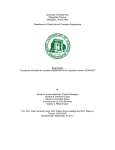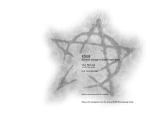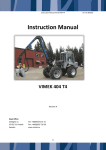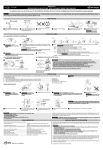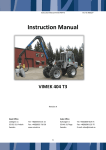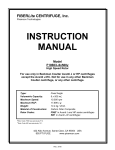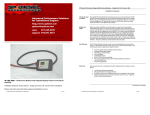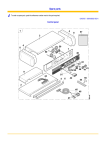Download FIAT 500 C - FC Connect
Transcript
FIAT 500 C -1- Fiat 500 C – S&S DOCUMENTATION AMENDMENTS/UPDATES Date Contact File Name Modification description © 2009 – Fiat Group Automobiles S.p.A. All rights reserved. The circulation and reproduction of all or part of this guide by any means is prohibited. Material processing cannot involve special liability for involuntary errors or omissions. The information in this guide is subject to continuous updating: Fiat Group Automobiles S.p.A. accepts no responsibility for consequences arising from the use of out-of-date information. This publication is for training purposes only. For up-to-date and comprehensive technical information for service purposes refer to the service manual and service information regarding the vehicle model in question. -2- Fiat 500 C – S&S BRIEFING .................................................................................................................................................. 5 SOFT TOP STRUCTURE .......................................................................................................................... 6 Soft top frame. ........................................................................................................................................ 6 Guides. .................................................................................................................................................... 9 Ribs. ...................................................................................................................................................... 10 Cover canvas. ....................................................................................................................................... 11 Interior trim. ........................................................................................................................................... 12 Rear window movement kinematic components. ................................................................................. 13 Rear spoiler........................................................................................................................................... 14 Front spoiler. ......................................................................................................................................... 15 Interior seal. .......................................................................................................................................... 16 MOVEMENT LOGICS. ............................................................................................................................. 17 Movement through buttons. .................................................................................................................. 17 Movement by remote control. Comfort opening. .................................................................................. 24 Soft top movement and vehicle speed. ................................................................................................ 24 Soft top movement and temperature .................................................................................................... 24 Emergency manoeuvre ......................................................................................................................... 25 Soft top initialisation. ............................................................................................................................. 25 Stop&Start and electrical soft top interaction ........................................................................................ 26 Tailgate-soft top interaction. ................................................................................................................. 26 Soft top management when the motor is locked. ................................................................................. 26 Soft top and climate control system interaction. ................................................................................... 27 Heated rear window-soft top interaction. .............................................................................................. 27 ELECTRICAL SYSTEM. .......................................................................................................................... 28 SPARE PARTS ........................................................................................................................................ 35 SUSPENSION STRUCTURE................................................................................................................... 38 Suspensions. ........................................................................................................................................ 38 Front suspension. ................................................................................................................................. 38 Rear suspension. .................................................................................................................................. 38 -3- Fiat 500 C – S&S -4- Fiat 500 C – S&S BRIEFING Expressing a "free and emotional" vehicle, the original convertible version pays tribute to the "opentop discovery" vehicle of 1957 while at the same time it offers vanguard solutions as for mechanics, engines and comfort on board. All this is aligned with the most authentic Fiat tradition that "democratizes" the access to contents and technologies never offered before in this vehicle segment. Thanks to its innovating soft top, a true "window to the sky", the new 500 C has the same dimensions of the basic model (it is 3.55 m long, 1.65 m wide and 1.49 m high) and shares all the three engine types: turbodiesel 1.3 Multijet, 75 HP engine, with 5-gear gearbox and two petrol 1.2, 69 HP and 1.4, 100 HP engines, both with gearbox or Dualogic robotized transmission. Each one has different qualities; the three engines are featured by their generousness, their lively behaviour and also by their high performance and sophisticated technology. Among standard qualities, instead, great reliability and respect for the environment. To confirm Fiat Automobiles commitment for environmental protection and sustainable mobility, the new 500 C includes (as optional) the innovative “Stop&Start” system, the device for engine temporary stopping and its following restarting. When the vehicle stops, placing the gearshifting lever in neutral and releasing the clutch, the engine switches off; to restart, you only need to press the clutch pedal (in case of gearbox). Created by Fiat Centro Stile and produced in the factory of Tichy (Poland), the vehicle was designed with an “open source” approach (that is the addition of new functions on a successful, already marketed product). Fiat 500 C indeed inherits all the winning features of the basic vehicle, such as the top safety, comfort in the compartment with 4 seats for adults and a luggage compartment that does not give up to precious cm of capacity. Among others, the luggage compartment - thanks to clever system of parallelogram hinges - gives an easier access even when the soft top is fully open. True design object, the soft top of Fiat 500 C is featured by the special kinematic movements of the electrical control and by the use of highly-refined and cared-for finishing technical solutions: from the glass rear window to the third brake light inside the soft top itself. The original soft top comes in three colours (ivory, red and black) and shall be matched to many body shades, with two special ones created especially for this new vehicle: a shining Pearly Red and a special Warm Grey peculiar of sports supercars. Not last, thanks to the innovative sliding soft top and the style concept keeping the vehicle sides, the Fiat 500 C can be enjoyed in any season of the year. In a word: all these peculiar features make this new vehicle one of the most successful examples of today's convertibles available in the city-car segment. Thus, the 500 C confirms Fiat unquestionable leadership in this segment; thanks to its continuous innovations, it always plays as a protagonist. As a matter of fact, this vehicle creates new standards as for comfort and safety, technique and outfit, without ever giving up to the unique "Italian style", absolutely unrivalled. A convertible offering great emotions is born, with top driving pleasure and matching a fascinating line with the performance of environmental-friendly, highly flexible engines. -5- Fiat 500 C – S&S SOFT TOP STRUCTURE The Fiat 500 C soft top system is formed by an electrical and a mechanical part. The electrical part is used for management and control; it is mainly formed by an ECU, a motor (with integral position sensor) and two movement buttons. Soft top movement buttons. The soft top mechanical part is mainly formed by: 1. 2. 3. 4. 5. 6. 7. 8. 9. 10. 11. soft top frame (stuck and screwed on the vehicle chassis) 2 guides (integral with the frame by rivets) Bowden cables and control unit (operated by the motor) 6 centre ribs, three out of which directly linked to the pads sliding inside the guides 1 rear rib + reinforcement at the base of frame cover canvas roof interior trim rear window movement kinematic components rear spoiler interior seal front spoiler Soft top frame. Soft top frame. -6- Fiat 500 C – S&S The soft top frame is fastened in 17 points to the body: 2 screws at the front, 6 nuts in the area next to the spoiler position and 9 screws at the back. The whole contour of the soft top frame is sealed. Soft top frame fastened on body. Front left side area (the centering element is visible) Front right side area (the centering element is visible) Rear spoiler position area (left side) Rear spoiler position area (right side) -7- Fiat 500 C – S&S Vehicle interior side area (left side) Vehicle interior side area (right side) Vehicle interior rear area (next to the control unit) Vehicle interior rear area (next to the motor) Vehicle exterior rear area. -8- Fiat 500 C – S&S Guides. On the soft top frame side parts the two guides are fastened by rivets; the movement pads are located in these guides. Guide Bowden cable and control unit. Control unit The Bowden cables slide inside the guides, pulled by a mechanism including a toothed reel operated by a motor. -9- Fiat 500 C – S&S Ribs. The ribs on the horizontal section are 7: 1 front rib and 6 centre ribs. The front rib, the second, the fourth and the sixth ribs are linked to the pads; they are the so-called movement ribs. The first, the third and the fifth ribs are not linked to the pads and mainly serve to support the roof. These ribs are moved by the movement ribs through special brackets (edges) they are linked to. The movement ribs are operated by front pads (linked to the front rib) sliding in the side guides, on their turn operated by Bowden cables pulled by the motor. The sixth movement rib is next to the rear spoiler. During horizontal movement, it stops and is fastened by two hooks (one on the left and one on the right side) of the soft top frame. When the roof starts its vertical movement, the hooks release the pads of the sixth rib from the soft top frame, to make it move. Seventh rib pad hooks (left side) Seventh rib pad hooks (right side) Centre ribs Pads - 10 - Fiat 500 C – S&S Cover canvas. The cover canvas through the front rib is fastened to the pads by four screws: two on the right and two on the left side. Soft top cover canvas with rear window. Canvas fastening screws to the first front rib, on the left side. At the back of the frame, a rib fastens the soft top cover canvas. Unlike the front rib and the six centre ribs, the rear rib is always stopped during the roof opening and closing movement. It only fastens the soft top cover canvas at the back. The rear rib is screwed to the soft top frame and contains a reinforcement bar. Reinforcement bar Rear rib - 11 - Fiat 500 C – S&S Interior trim. Ribs and guides are coated by an interior trim inside the car. Interior trim The interior trim is fastened to the ribs and is operated during movement. - 12 - Fiat 500 C – S&S Rear window movement kinematic components. The rear window is made of glass and, during the soft top vertical movement, it must carry out a slight transfer and following rotation movement, so that the exterior cover canvas can be wound up in soft top total opening position. Left side rear window movement kinematic components. 1 Detail A of left side kinematic components Detail B of the left side kinematic components The slight translation and following rotation movement is achieved by a kinematic movement formed by a set of levers. These kinematic components are operated by the movement of pads 1, as shown in the illustration of detail B of the kinematic components. The illustrations show the kinematic component details on the soft top left side, on the right side the kinematic components are symmetrical. - 13 - Fiat 500 C – S&S Rear spoiler. A spoiler over the rear window supports the third brake light as well. Rear spoiler The spoiler is fastened by four screws on a cross member between the rear window and the sixth horizontal rib. The cross member is linked to the rear window movement kinematic component by four screws; being the rear window linked to the sixth movement rib, the spoiler can follow the soft top vertical movement. Screws securing the spoiler to the cross member. - 14 - Fiat 500 C – S&S Front spoiler. Front spoiler A spoiler is located in the front part of the soft top; it can be lifted to improve aerodynamic comfort inside the compartment. In the centre of the spoiler a retaining tooth makes it integral to the soft top frame. To lift the spoiler, just move the retaining tooth to the right (passenger's side) as shown in the picture. Front spoiler retaining tooth. - 15 - Fiat 500 C – S&S Spoiler canvas. The front spoiler lifts a canvas usually folded when the spoiler is closed. The canvas is linked to the spoiler at the top and to the soft top frame at the bottom, by rivets. The spoiler must be raised when the roof horizontal section is open, at speeds over 60 km/h. When the roof is fully open, the spoiler should be lowered, to prevent wind noises from entering the compartment. Interior seal. Next to the area between soft top frame and body, a seal covers the whole contour, excluding the soft top frame rear part. Rubber seal. The seal is in butyl-based rubber. This special type of rubber features a thick molecular structure, highly resistant to gas flow; this rubber has also a high breaking load. - 16 - Fiat 500 C – S&S MOVEMENT LOGICS. The roof movement can be achieved in two ways: 1. Movement through interior buttons. 2. Movement by remote control for door locking/release. The roof opening and closing can be made according to two modes: • Manual if the opening/closing buttons are pressed for an activation time “Ta” between 50 ms and 300 ms: 50 ms < Ta < 300 ms (short control). Releasing the button, the roof movement stops. In manual mode, the roof can be moved only in the horizontal area. • Automatic if the opening/closing buttons are pressed for an activation time “Ta” over 300 ms: Ta > 300 ms (long control). The automatic movement concerns the soft top (roof) horizontal area and the soft top vertical area (here the movement can only be automatic). Here below, sequentially, the operating logics for the roof automatic movement during opening and closing steps are described. Movement through buttons. Starting condition: fully closed roof. Pressing the opening button once, the roof opens automatically until reaching the full horizontal opening position (spoiler position) Complete closing position Complete horizontal opening position (spoiler position) - 17 - Fiat 500 C – S&S Pressing the opening button once, the roof starts its movement towards the full horizontal opening position (spoiler position). If, before reaching the spoiler position, the button (opening or closing) is pressed again, the roof stops in an intermediate position in the horizontal section. Complete closing position. Intermediate closing position on horizontal section From the intermediate horizontal opening position, pressing the opening button once, the roof continues the automatic movement until reaching the full horizontal opening position (spoiler position). Complete opening position (spoiler position) - 18 - Fiat 500 C – S&S Starting condition: roof in spoiler position From the spoiler position, pressing the opening button once, the roof goes automatically to the full vertical opening position. Complete horizontal opening position (spoiler position) Complete vertical opening position From the spoiler position, pressing the opening button once, the roof moves automatically. If, before reaching the complete vertical opening position, the button is pressed again, the roof stops and reverts its movement, going back to the spoiler position. No intermediate positions are allowed for the vertical section. - 19 - Fiat 500 C – S&S Roof in spoiler position Roof in vertical opening process Roof in spoiler position after pressing the button. - 20 - Fiat 500 C – S&S Starting condition: fully open roof. Starting from the fully open roof position, pressing the closing button once the roof closes automatically until reaching the spoiler position. Roof in vertical opening position. Roof in spoiler position. The vertical opening control is prevented if the tailgate is open. This is due to the fact that the tailgate opening position would interfere with the rear window movement. Vice versa, when the roof is in full vertical opening, the tailgate opening is prevented: pressing the release button, the roof moves automatically and only when it reaches the spoiler position the tailgate lock is released. From the fully open position, pressing the closing button, the roof closes towards the spoiler position. If, during the movement between "fully open" to the "spoiler" position, the button is pressed again, the roof stops and the movement is reversed, going back to the "fully open" position. - 21 - Fiat 500 C – S&S Roof in full opening position Roof in closing process Roof in closing and movement reversal process. - 22 - Fiat 500 C – S&S From roof in spoiler position to roof fully closed. From the spoiler position, pressing the closing key once, the roof starts closing automatically up to about 25 cm from the fully closed position. In the last 25 cm closing must be completed manually keeping the closing button pressed. Considering that the anti-pinch function is not included, this operation logic has been designed to preserve the safety of the vehicle passengers that could accidentally be projecting from the vehicle itself during closing. AUTOMATIC CLOSING 25 CM: MANUAL CLOSING - 23 - Fiat 500 C – S&S If, during automatic horizontal closing the closing/opening button is pressed, the roof movement stops in an intermediate position. Pressing the closing button again, the roof continues its automatic closing movement up to about 25 cm from the fully closed position, then closing must be completed manually. Roof opening and closing in the horizontal section can be made only under 60 km/h. For the vertical section, the same speed threshold applies. Movement by remote control. Comfort opening. The remote control is allowed only with engine switched off and closed doors. The remote control can only open the roof in its horizontal section (up to the spoiler position). Continuously pressing the "release" button C, the roof opens and stops in any position when the button is released. The soft top closing by remote control is not allowed. Soft top movement and vehicle speed. The driver can move the soft top in the horizontal and vertical sections if the vehicle speed is below 60 km/h. If, during the vertical movement, the vehicle speed exceeds 60 km/h, the soft top must reach one of the two safety positions (spoiler or fully open) before stopping its movement. This means that: • if the vertical section is being closed when 60 km/h are exceeded, the soft top must reach the spoiler position before stopping. • If the vertical section is being opened when 60 km/h are exceeded, the soft top must reach the fully open position before stopping. Soft top movement and temperature The soft top can be moved in any temperature condition between -18°C and 80°C. Between -30°C and - 18°C only a closing control is allowed. Below -30°C no movement is allowed. - 24 - Fiat 500 C – S&S Emergency manoeuvre If the control buttons fail, the soft top can be moved manually proceeding as described below: 1. take the supplied wrench A placed in the luggage compartment with the tool box or the Fix & Go. 2. Fit the wrench in the suitable housing inside the luggage compartment, under the rear shelf, as shown in the figure. 3. Turn: in clockwise direction to open the soft top and counter-clockwise to close it. Soft top initialisation. As a result of an emergency manoeuvre, the soft top could fail to operate automatically. The initialisation procedure must be carried out. This can be made by Examiner in BCM diagnosis mode. The initialisation procedure is guided by the diagnosis instrument, informing the operator about the operations to be made on interior movement buttons. At the end of the operations, if the initialisation procedure was positive, the soft top carries out the following cycle, automatically: 1. complete opening 2. complete closing 3. opening up to spoiler position In case of battery disconnection, the soft top system does not lose its operating automatic movements. - 25 - Fiat 500 C – S&S Stop&Start and electrical soft top interaction If the Stop&Start function (optional) is implemented in addition to the electrical soft top system on the Fiat 500 C, these two systems must coexist in all those situations where both of them need to operate. First of all, the electronic control unit for the soft top system receives all information on the S&S function status from the BCM, through a LIN dedicated line. The critical condition for the soft top system occurs when the request of engine stop or a restarting request of the engine occurs simultaneously with a soft top movement. Due to this critical condition, some peculiar situations must be defined: engine stop request during the roof movement. If the engine stops during the roof movement, the latter can continue moving without jeopardising its movement performance. Roof movement request during the stopping time of the engine. If the roof motor, according to a movement request by the driver, asks for a high current value (due to possible interference), the engine could be restarted and the roof movement is delayed until the engine completes the starting stage. Under such conditions, if one gear is engaged, the engine cannot be restarted and the roof is not moved. Instead, if the motor can be operated with standard values of the uptake current, the roof movement is made without necessarily restarting the engine (all this clearly depends on the battery charge value). Engine restarting request during the movement. If the engine restarting request occurs during the roof movement, the RCU control unit stops the movement and the engine can start. When the engine completes the starting stage, the roof movement restarts and is completed. Tailgate-soft top interaction. The Body Computer BCM receives the release request of the tailgate from the button on the handle or by the button on the remote control. For every release request, BCM must be informed about the soft top current position: if the soft top is in the spoiler position, stopping in any intermediate position of the horizontal section or if it is fully closed, the BCM can release the tailgate lock. To guarantee the tailgate correct opening when the soft top is fully open, or during its vertical movement (opening or closing), the BCM asks the RCU (through LIN line) to bring the soft top next to the spoiler position. When the spoiler position is reached, the BCM releases the tailgate lock. If the tailgate is open and, at the same time, the soft top opening is required, the opening movement is not performed. Under these conditions, only the soft top closing movement is allowed. If the tailgate lock release request is controlled while the soft top is moving in the horizontal section, the movement stops immediately (without reaching safety positions) and the BCM can release the lock only after being informed by RCU that the soft top movement has been actually interrupted. When the RCU interrupts the soft top movement, the same can restart only after pressing the movement interior buttons. Soft top management when the motor is locked. During the soft top movement, the motor could suddenly lock. The motor can be locked mechanically (seizing or obstacles) or thermally. The RCU control unit involves some strategies to manage this type of situation. Motor locked in the horizontal section. If, during the movement in the horizontal section, the soft top stops as a result of the motor locking, the opening and closing controls from the interior buttons are prevented for 30 seconds. The same applies to the opening movement operated by the remote control. - 26 - Fiat 500 C – S&S Motor locked in the vertical section If, during the closing movement in the vertical section, the soft top stops as a result of the motor locking, the movement is reversed until reaching the fully open position. The closing control by the interior button is prevented for 30 seconds. If, during the opening movement in the vertical section, the soft top stops as a result of the motor locking, the movement is reversed until reaching the spoiler position. The opening and closing movements from interior buttons are prevented for 30 seconds. Soft top and climate control system interaction. The Body Computer BCM sends through a B-CAN network all information concerning the roof position. All information is used by the climate control system node NCL to manage the climate inside the compartment in the best way. If the soft top is open, the climate control system node manages the fans to preserve their operation. In case of a high difference outside temperature and the temperature set by the driver on the climate control system node, with open soft top, the interior temperature sensor would detect always a rather high temperature; thus, the fan would work always at high speed and risk following damage. Under these conditions, the climate control system node decreases the fan speed. The climate control system compressor is operated by the driver even if the soft top is open. Heated rear window-soft top interaction. The heated rear window, like all non-convertible versions, is 20 minutes in total, with the following difference: Fiat 500 – 10 minutes engine off + 10 minutes engine on Fiat 500 C – 15 minutes engine off + 5 minutes engine on The defrosting function, meant as heated rear window and heated mirrors, if installed, can be enabled only if the soft top is closed. If the function is operating and the soft top is opened, it deactivates. In this case, when the roof is closed, to restore the defrosting function press the button again. - 27 - Fiat 500 C – S&S ELECTRICAL SYSTEM. The soft top system electrical part is formed by: 1. Motor (with Hall effect position sensor). 2. RCU control unit (Roof Control Unit) Motor. RCU control unit (Roof Control Unit). Wiring harness. The RCU control unit and the motor are located at the back of the soft top. They are both fastened on the soft top-frame part below the rear window. - 28 - Fiat 500 C – S&S RCU control unit and motor. The motor includes a Hall effect position sensor. The "fully open" and "fully closed" positions are stored by the ECU during learning (initialisation) the first time by Fiat Auto Poland factory. The RCU, depending on the total stroke and on the information sent by the sensor, calculates intermediate positions, including the spoiler position. Operating diagram. Opening switch INPUT OUTPUT RCU Motor Closing switch FeedBack LIN INPUT OUTPUT BCM - 29 - Fiat 500 C – S&S The BCM body computer input data are: • • • • • • AutoStart (concerning the S&S function intervention) Luggage compartment lock release (information coming from the button on the tailgate handle or from the remote control) Comfort Opening (from the lock release button of the remote control) Vehicle speed Outside temperature Key status (key on/off) The information sent by the Body Computer output concerns the soft top position. All information is sent through B-CAN network and is used by the climate control node NCL to manage the climate control system when the soft top is open. The Body Computer node - BCM transmits and receives data to/from the soft top control unit RCU through a LIN line. BCM sends the following information to the RCU control unit: • Intervention of the S&S function (Autostart) • tailgate release request; tailgate status • vehicle speed • outside temperature • “Comfort opening” control • key status (key on/off) The Body Computer BCM receives from the RCU feedback signals, to know the true position of the roof, the correctness of movement controls; it can store possible malfunctioning errors. The RCU cannot undergo diagnosis procedures. The errors for the soft top management are stored in the BCM. The RCU interfaces with the user through the opening and closing buttons. The RCU output is the control of the motor. The latter sends a feedback signal to the RCU, concerning the soft top position by the relevant Hall effect sensor. - 30 - Fiat 500 C – S&S Wiring diagram. - 31 - Fiat 500 C – S&S Key: M001: Body Computer Node B001: Engine compartment control unit H130: Opening/closing buttons M187: Roof Control Unit (soft top control unit) M193: Motor (with integrated position sensor) RCU control unit PinOut: 1. 2 3 4 5 6 7 8 9 10 11 12 13 14 15 16 +30 battery supply GND earth for integrated Hall effect sensor bus LIN line soft top opening control (opening switch) soft top closing control (closing switch) n.c. n.c. connection to motor connection to GND earth n.c. n.c. n.c. position sensor 1 signal position sensor supply position sensor 2 signal connection to motor motor PinOut. Motor side connector 1 2 3 4 5 6 motor control from RCU motor control from RCU position sensor supply position sensor GND earth position sensor 1 signal position sensor 2 signal - 32 - Fiat 500 C – S&S Diagnosis and recovery conditions. In the following table, the signals exchanged between BCM and RCU are listed, concerning the diagnosis strategies and the possible recovery strategies. Diagnosis signals Vehicle speed status failure Description It is set when the vehicle speed signal is invalid. It is set when the outside temperature sensor sends an invalid value to the BCM. It is set when the RCU sends BCM information about an incorrect roof position. It is set when the activation switch is pressed for over 60 seconds Malfunctioning opening interior button Recovery strategies The roof is not moved. Roof closing switch failure Malfunctioning button interior The roof cannot be moved in opening H_Bridge failure** It is generated as a result of absorption overcurrents, overheating, short circuit to Vbatt or GND It is set when the motor locks suddenly Motor in short circuit or overheating The relevant error is reset once the system cools down or current decreases. Outside failure temperature status Roof position failure Time_out failure* Roof opening switch failure Locked motor system Motor system failure Battery voltage initialisation under closing It is set during the initialisation procedure and a battery voltage decrease is detected The roof is not moved. The roof is not moved. Soft movement function prevented until the button is released. The roof cannot be moved in opening Prevention for 30 seconds and new control to be sent Once the short circuit has been removed, or the system has cooled down, enter the control again Repeat the initialisation procedure. * TIMe_OUT failure concerns the opening or closing button activation time. If either button is pressed (locked) for a time longer than 60 seconds, the RCU prevents the soft top movement until the locked button is released. ** H_BRIDGE belongs to the motor overvoltage protection system. It is mainly an additional circuit inside the motor, that can take up the overvoltage and reduce motor overheating. No communication on LIN line. If the communication on LIN line disappears, the soft top cannot be moved anymore through the interior buttons and the remote control. Under such conditions, the RCU cannot be woken up by the interior buttons, as the key status (key on/off) is sent only by LIN. If the soft top is being moved and the LIN line stops working, thus stops communicating, the soft top locks and it cannot be closed anymore. The closing is possible only through emergency manoeuvres. - 33 - Fiat 500 C – S&S Failure code list - DTC. DTC Description Cause Detection conditions B1061 RCU Roof movement control unit faulty Incorrect performance or operations The DTC is stored if the BCM receives from the RCU one of the following signals: U0207 B1087 Roof movement control module faulty Roof movement control module missing Roof movement control module irregular LIN2 – open circuit. Wrong message length on LIN line Messages on LIN line missing Error response status from RCU LIN2 failure – short circuit to GND; short circuit +battery. Contact to GND or battery - 34 - - Roof position failure - Timeout failure. - Roof opening switch failure - Roof closing switch failure - H_BRIDGE failure. - Motor failure. - Locked motor. Detected wrong length on LIN line message Missing messages from RCU to BCM Fiat 500 C – S&S SPARE PARTS The following table lists all the components and the kits to be supplied as spare parts: KIT No. DESCRIPTION REMARKS 1 EXTERIOR CANVAS Include fasteners, stitching, etc... glue, 2 ROOF TRIM Include fasteners, stitching, etc... glue, 3 LH REAR WINDOW KINEMATIC COMPONENT LEVERS Include fasteners 3 bis RH REAR WINDOW KINEMATIC COMPONENT LEVERS Include fasteners 4 SPOILER Include fasteners 5 THIRD BRAKE LIGHT Include fasteners 6 CENTRE RIBS Single kit with no. 6 ribs 7 LEFT GUIDE Include fasteners INTERIOR IMAGE - 35 - Fiat 500 C – S&S 7 bis RIGHT GUIDE Include fasteners 8 REAR RIB + REINFORCEMENT Single kit with both elements 9 CONTOUR SEAL Include butyl 10 PLASTIC COVERS Single kit with no. 4 covers (front + rear, LH + RH) 11 COMPLETE WIND DEFLECTOR Include fasteners 12 WIRING HARNESS 13 CONTROL UNIT 14 MOTOR Include fasteners 15 DRIVE UNIT Exclude Bowden cables - 36 - Fiat 500 C – S&S 16 DRIVE UNIT BOWDEN CABLE Managed as a single piece Quantity 2 on vehicle 17 LH MECHANISM ASSEMBLY Include LH strap 17 bis RH MECHANISM ASSEMBLY Include RH strap - 37 - Fiat 500 C – S&S SUSPENSION STRUCTURE. Suspensions. The suspensions allow the vehicle to undertake any type of route, without transmitting the bumps from the wheels into the passenger compartment, reducing side oscillation (rolling) and longitudinal oscillation (pitching) of the body. The 500 C version has new variants vs. the basic vehicle. Front suspension. Independent, McPherson type front suspension with spheroid cast iron track control arms secured to an auxiliary cross member. Offset coil springs and double acting telescopic hydraulic shock absorbers. Anti-roll torsion bar. Spheroid cast iron track control arms with new bushes fitted at the back of the vertical axle to improve the absorption of vibrations and road holding when cornering. Side load type coil springs that allow better reduction of stem tangential forces with resulting improved absorption of slight unevenness in the road surface. Dual acting telescopic hydraulic shock absorbers. Upper shock absorber mounting with improved axial rigidity to improve comfort. The wheel strut has an increased transverse camber angle to improve camber angle when cornering (wheel perpendicular to the ground). Rear suspension. The torsion beam rear suspension (semi-independent wheels) has an anti-roll bar coming from 500 Abarth version. Rear suspension of the basic model has no anti-roll bar. Coil springs and double acting telescopic hydraulic shock absorbers. Front and rear wheel hubs on versions equipped with ABS have a special bearing for active sensors which replaces the toothed wheel on previous systems. The advantages of this solution are: • • • • Similar kinematic behaviour to independent wheels with associated functional advantages Cross member stabilising function improved by the anti-roll bar Excellent comfort thanks to the improved vertical flexibility Excellent handling thanks to the higher stabilising action due to the anti-roll bar - 38 - Fiat 500 C – S&S • • Reduced weight Pre-assembly of suspension before installing it on the vehicle. There are two rear axle versions depending on the vehicle version. The following illustrations show that the structure of the rear axle is similar for both versions, the difference is the presence of: Drum brakes for the 1.2 8V petrol engine and 1.3 Multijet versions Full disc brakes for the 1.4 16V petrol engine version. 1.2. 8V petrol / 1.3 Multijet version 1.4 16V petrol version - 39 - Fiat 500 C – S&S The torsion beam suspension is secured to the body with: pressed-steel mounting brackets; each bracket is secured to the body by three screws. Non-structural dual tube shock absorbers with horizontal lower bushing (y axis) and horizontal upper bushing for fastening to the rear rail. The coil springs are lodged between the lower plate on the axle and the upper mount welded onto the side rail; there is a rubber element between the upper mount and the spring. The end stop buffers are made from Cellasto; for this reason, because of their shape, they are secured to a mount welded onto the rear rail that also serves as the upper support surface for the spring. - 40 - Fiat 500 C – S&S








































